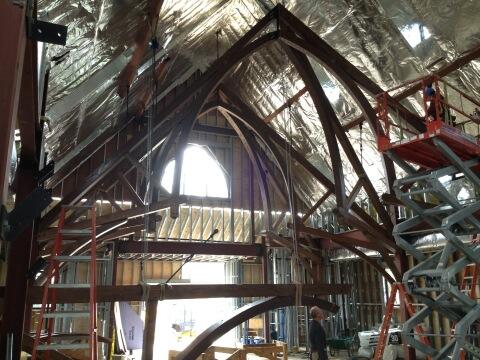Wednesday, April 24, 2013
Unique Timber Frame Home
Unique buildings are where we really shine, here at Vermont Timber Works. Yes we do simple trusses and barns and pavilions but (at least in the engineering department) the ones we find most enjoyable are the ones that make us stop and scratch our heads. Sometimes we stop and scratch our head because we just aren't sure how the timber frame incorporates itself into the rest of the building. Other times the frame is really unique and is a one off situation. Sometimes it's a combination of the two, which is the case for the frame pictured above.
The frame pictured above is a residence. I could not have drawn it without the help of the architects bid documents, imported dxf file, or pictures of the balsa wood model that was created. The floors step up and down and even though it's hard to see, each roof surface has multiple pitches to it. The other aspect that is difficult to draw is that none of the walls really line up on top of each other. All these complications combine to make it hard to track the loading thru the building down to the foundation. This is when us engineers stop and scratch our heads.
Wednesday, April 10, 2013
Douglas Fir Saltbox
It's quiet this week in the office. Almost all of the people in the shop are down in Connecticut raising some trusses for a church.

So, while they are away I'm working on a Saltbox on an island in Canada. Even for being a smaller frame all of the walls have lots of glass so I'm sure that the views on site are incredible. Seismic loading is going to control the lateral design of this frame. So what is a saltbox house? Well, read this Historic House Blog to get more information.

So, while they are away I'm working on a Saltbox on an island in Canada. Even for being a smaller frame all of the walls have lots of glass so I'm sure that the views on site are incredible. Seismic loading is going to control the lateral design of this frame. So what is a saltbox house? Well, read this Historic House Blog to get more information.
I f you want to see more styles of timber frames like this saltbox, visit Vermont Timber Works.
Thursday, April 4, 2013
Timber Truss with Double Chord
This truss has a double top and bottom chord and all of the webs and steel are sandwiched between them. Because this truss is located in an area that has high wind loads, the steel was changed from rods to pipes. The pipe can take the compression forces when the truss reverses in a high wind situation. The truss material was specified as number 1, closed grain, redwood. Are you wondering what the difference is in open and closed grain? Check out The Nature of Wood for more information.
If you want to see more trusses like this, visit Vermont Timber Works.
Subscribe to:
Posts (Atom)


